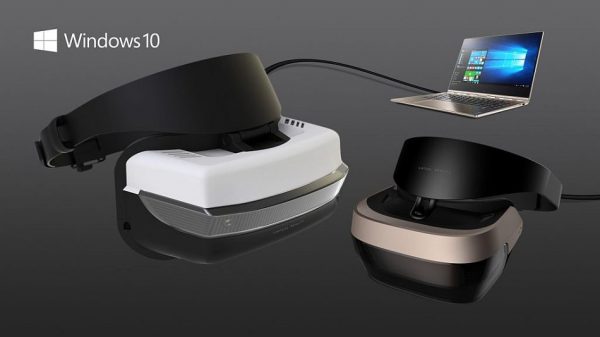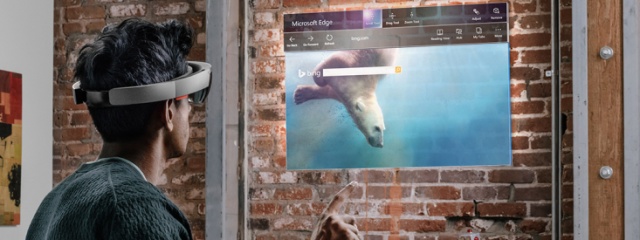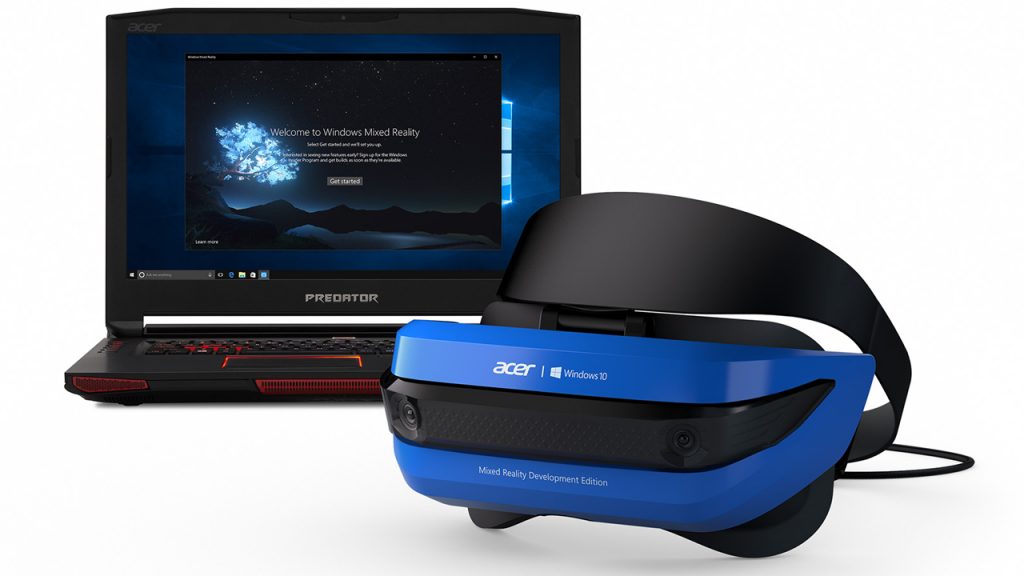Microsoft virtual reality headsets are becoming real thanks to Acer
I have already dedicated some articles about the Microsoft virtual reality headsets because I’m very curious about them. Microsoft promised these cheap VR headsets that works out of the box with Windows 10 and that provide positional tracking without external cameras, claiming that they’re even better than Oculus or Vive! In January they revealed them, but until yesterday no one had ever tried them.
At GDC 2017, finally, the first Windows 10 VR headset has been presented: it is made by Acer and offers all characteristics that Microsoft has promised: good graphical quality, inside-out tracking and cheap price ($299).
Some selected journalists have been able to try the prototype (but they couldn’t shoot photos or videos, damn!) and the feedbacks are:
- It’s a bit like PSVR;
- It is tethered;
- It is not comfortable;
- Framerate is still 60fps;
- Blurred graphics;
- Seldomly the positional tracking has glitches;
- The experience sometimes crashes;
- The controller is a gamepad.
- It has flip-up display: meaning you can flip up the hmd just to return to the real world and flip it down again to go virtual (cool!);
- It has inside-out tracking, so it doesn’t require external cameras;
Eeeeeh, I don’t know if this was what we were all expecting. The feedback is the one of a mediocre cheap headset. But if you’re a Microsoft fan, don’t worry: this is not the finished version… they made someone to try the headset just to get some visibility. The final version should come in “the next weeks”, but given the above problems I guess “the next months” (because, come on, when you make the most important VR journalists to try your headset, you show them the best possible one… and if this is the best, there’s still a lot to do).
When this final version will be ready (90 FPS, no bugs), they’ll start shipping the HMDs to partners and developers first, as always. Kipman has said that they will start later this month… maybe they’ll start sending this prototype to selected people later this month, and in the next months they will instead ship the final version to more devs.
So, the feedback is: nice try, but we want to see the final version for a real judgement.

On the hardware side there’s another news: next Xbox, Scorpio, will support virtual reality but this support will come in 2018. This shows how Microsoft roadmap on *R technologies has a very long term vision. But makes me wonder if it has sense to wait so long. Playstation supports VR since some months and Sony has just claimed that it sold nearly 1 million PSVR headsets in this period. Waiting more than one year (one year!!) seems like a crazy choice to me, unless they’ve made some business calculation and they know that VR will skyrocket in 2018. Are they leaving one year advantage to Sony?? In the meanwhile you can only stream Xbox games to virtual reality headsets (basically in VR you see yourself playing the Xbox game onto a giant screen).
Xbox addition makes the vision of Windows 10 mixed reality platform to grow further. As I’ve already said in this article, the plan of Microsoft is to make with AR/VR the same thing that made lots of years ago with screens and other peripherals. Do you remember that old times when you had to select the screen type when you started a game? (Pepperidge Farm remembers!)

This pain ended when Windows started abstracting all devices, so now when you make a game for PC, you have not to choose the devices you’re developing for.
With VR we’re still in the old times: you’ve to choose if you want to develop for Oculus, SteamVR, OSVR, etc… Microsoft wants you to just develop for Windows 10, with Windows 10 caring about all the stuff for you. And having tried the Hololens SDK, I can say it is also very rich of features, so it’s good for developing. This is very powerful and that’s why all major headset producers are scared.
Windows 10 does not cover only desktop PC. It has also Xbox and Hololens. So you develop once and then deploy on all Windows 10 devices. The only real missing platform is mobile, but that’s because Windows Phone is just a little niche.
So you may be wondering: but how is it possible to treat AR and VR as the same thing when you develop? Or when you see the desktop? Nice question and Microsoft has answered in a clear way: your room is your desktop. In AR this seem obvious: you just put twitter, skype and all this apps hanging from walls and when you launch an immersive experience it just takes all your room, hiding the others. In VR they did a simple trick: you see yourself in a virtual room, where you have AR: so twitter is hanging from the virtual walls of your virtual room and so on. It’s like the room of Oculus Home, but with the difference that you can put VR widgets on all walls, the floors, etc… There are still some design issues (there’s no chaperone, so you just have no idea where you are in the real room!), but the idea is clever. My thoughts on this are:
- This design is more natural than all the others: Oculus Home is already a virtual room, but all the interactions happens in 2D. In this Microsoft Start Room (I’ve invented the name right now) you just interact with the 3D room as it were a real room, so you interact with walls, etc…
- This design is in favour of AR: VR becomes an “emulation” of AR, where you see yourself doing AR inside a VR room (my head is spinning, now :D). This clearly shows how Microsoft is more interested in AR, since this is surely the technology that will be more pervasive in the future;

- This means that, like with Hololens, you’ll be able to even launch multiple VR apps together. At the moment this is not possible.
- This design lets you see completely windows while you’re in VR. Since in the virtual room you have exactly Windows 10, you can do everything while you’re in VR. You can play Onward, than close it and finding yourself in the Start Room, open a Word widget, attach it to a wall and start writing. This lets you live all in VR, without switching from VR and non-VR all the time. I wonder how companies like Virtual Desktop (whose purpose is very similar) will survive to this.
Kipman says a super-interesting thing about market of these devices:
HoloLens is focused on task workers and enterprise. The affordable headsets starting at $299 are entirely focused on gaming and entertainment
HoloLens costs $3000, so surely it’s not an indie hardware. This new hardware, instead, is for indies. It’s a way for Microsoft to enter the *R market in the short term, while HoloLens is the long term continuation of their plan to conquer the world.
So, I continue to be seriously intrigued by these new headsets. And you?
(Header image by Microsoft)
Disclaimer: this blog contains advertisement and affiliate links to sustain itself. If you click on an affiliate link, I'll be very happy because I'll earn a small commission on your purchase. You can find my boring full disclosure here.



